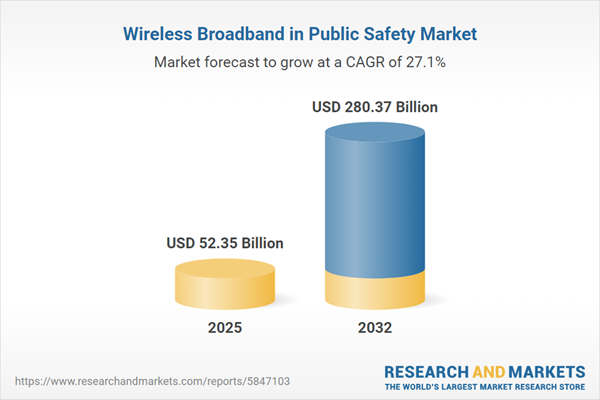Speak directly to the analyst to clarify any post sales queries you may have.
Wireless broadband is transforming public safety communications, providing agencies with secure, flexible networks that power digital modernization and improve operational adaptability. As technology demands increase, agencies require reliable wireless broadband to effectively manage safety and security challenges.
Market Snapshot: Wireless Broadband in Public Safety
The wireless broadband in public safety market continues to see strong and sustained growth, driven by the critical need for fast, dependable, and secure communication tools across emergency response and law enforcement operations. Ongoing digital transformation initiatives are accelerating growth in the sector, with expansion forecasted between 2024 and 2025 and further momentum anticipated through 2032. Agencies are investing in advanced wireless infrastructure to enhance decision-making and support resilience. Both urban and rural jurisdictions depend on scalable broadband for effective communication and rapid response, ensuring seamless service continuity for routine activities and during crisis situations.
Scope & Segmentation of the Wireless Broadband in Public Safety Market
- Technology Platforms: Integration of 5G, LTE, high-capacity microwave, and multi-orbit satellite technologies (GEO, LEO, MEO), as well as modern Wi-Fi standards, enables robust and reliable wireless broadband connectivity essential for evolving public safety requirements.
- Key Applications: Use cases include secure data transfer, high-definition video streaming for real-time situational awareness, resilient voice communications, and seamless integration with IoT sensors to support agency agility and informed operations.
- Licensing Model: Agencies leverage both licensed and unlicensed spectrum, ensuring operations remain compliant and adaptable to various mission-critical scenarios.
- Frequency Spectrum: Strategic allocation across frequency bands supports effective connectivity for public safety—meeting the differing needs of densely populated urban centers and challenging rural landscapes.
- Network Architecture: Hybrid systems combining terrestrial infrastructure and satellite networks guarantee mission continuity and effectiveness, even in adverse operational circumstances.
- Regional Markets: North America leads in the integration of legacy and new platforms; EMEA focuses on long-term infrastructure upgrades; Asia-Pacific prioritizes scalable digital technologies for urban environments, with region-specific priorities driven by regulatory and operational imperatives.
- Key Companies: Industry leaders such as AT&T Inc., Verizon Communications Inc., Motorola Solutions, Inc., Nokia Corporation, LM Ericsson, L3Harris Technologies, Cisco Systems, Inc., Leonardo S.p.A., Airbus SE, and Thales S.A. adjust offerings to align with public safety compliance needs and sector-driven demands.
Key Takeaways for Senior Decision-Makers
- Reliable wireless broadband strengthens interagency coordination, allowing for integrated systems and streamlined incident response.
- Modern wireless networks equipped with edge and cloud features help agencies flexibly handle large and growing data volumes while adapting to emerging operational requirements.
- Adopting AI and IoT within wireless broadband systems enhances real-time situational awareness, supporting faster and better-informed decision-making across public safety operations.
- Growing public-private partnerships are streamlining regulatory alignment and simplifying complex infrastructure upgrades, which encourages the adoption of next-generation wireless technologies.
- Regional approaches, such as North American system integration or Asia-Pacific’s focus on advanced analytics, shape tailored wireless broadband deployment strategies.
- The scalability of broadband solutions underpins continuity for both daily operations and large-scale emergency events, ensuring agencies remain resilient and responsive.
Tariff Impact: Navigating Regulatory Developments
New wireless broadband tariffs in the United States, set for implementation in 2025, are pushing public safety agencies to reassess procurement and budget strategies. Disruptions in global supply chains—especially for critical hardware and semiconductors—are leading to increased lead times and prompting diversification among suppliers. To address these challenges, manufacturers are turning to localized production models to stabilize costs, reduce project delays, and help agencies comply with evolving regulatory mandates and infrastructure objectives.
Methodology & Data Sources
This analysis is based on a blend of qualitative and quantitative research techniques, including review of regulatory trends, interviews with practitioners and manufacturers, targeted surveys, scenario modeling, and cyber risk assessment. The approach ensures that market intelligence provided is practical for real-world decision-making in public safety communications.
Why This Report Matters
- Gives senior leaders the insights needed to select wireless networks and technology partners that support modernization and regulatory compliance.
- Clarifies shifts in supply chain and regulatory landscapes to assist with procurement planning and organizational risk management.
- Supports effective allocation of resources to strengthen adaptability and operational resilience in the face of changing requirements.
Conclusion
Integrated wireless broadband infrastructure forms the backbone of effective, resilient public safety communication. This report provides senior decision-makers with essential guidance to plan and invest with confidence for both current and future operational demands.
Additional Product Information:
- Purchase of this report includes 1 year online access with quarterly updates.
- This report can be updated on request. Please contact our Customer Experience team using the Ask a Question widget on our website.
Table of Contents
3. Executive Summary
4. Market Overview
7. Cumulative Impact of Artificial Intelligence 2025
Companies Mentioned
The companies profiled in this Wireless Broadband in Public Safety market report include:- AT&T Inc.
- Verizon Communications Inc.
- Motorola Solutions, Inc.
- Telefonaktiebolaget LM Ericsson
- Nokia Corporation
- L3Harris Technologies, Inc.
- Cisco Systems, Inc.
- Leonardo S.p.A.
- Airbus SE
- Thales S.A.
Table Information
| Report Attribute | Details |
|---|---|
| No. of Pages | 181 |
| Published | November 2025 |
| Forecast Period | 2025 - 2032 |
| Estimated Market Value ( USD | $ 52.35 Billion |
| Forecasted Market Value ( USD | $ 280.37 Billion |
| Compound Annual Growth Rate | 27.0% |
| Regions Covered | Global |
| No. of Companies Mentioned | 11 |









